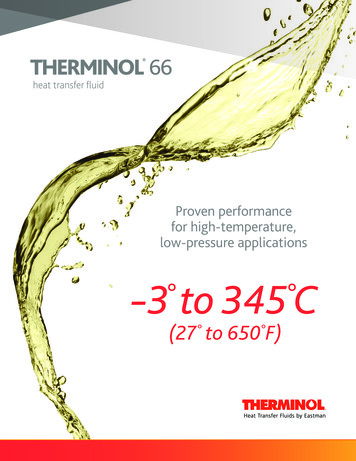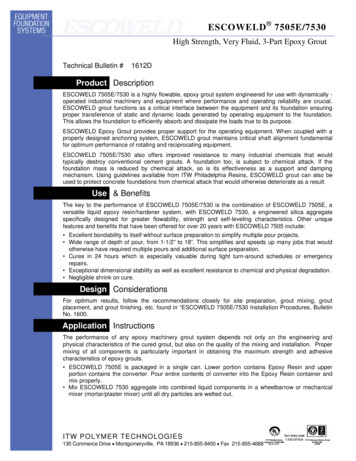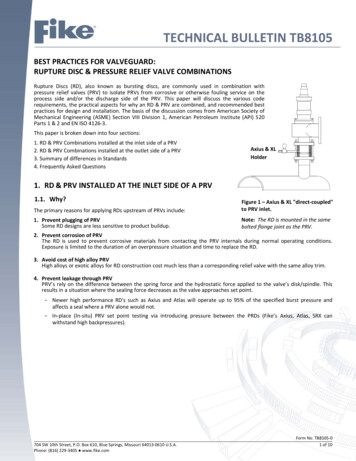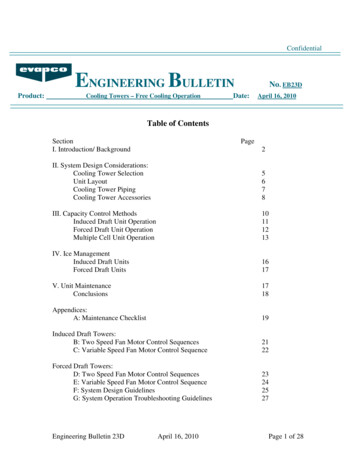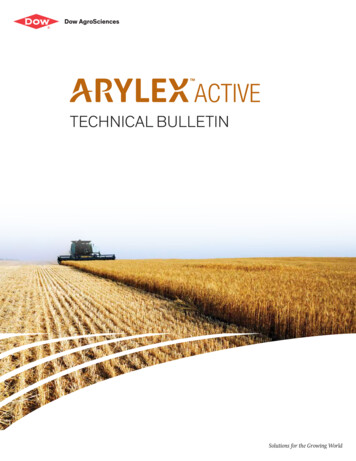
Transcription
Technical BulletinSolutions for the Growing World1
OverviewArylex activeA new herbicide for the control of broadleaf weeds with utility in multiple crops. Arylex is an innovativelow-dose growth regulator herbicide for use in mixtures with other Dow AgroSciences proprietaryherbicides creating a wide spectrum of products customized for specific geographies.Discovered by and proprietary to Dow AgroSciences, Arylex is the first member of a new structural classof synthetic auxin herbicides. Postemergence use rates in cereals will typically range from 5 – 10 gramsae/hectare depending upon target weed species and geography. The auxinic mode of action of Arylexwill be effective in managing weed biotypes resistant to other modes of action such as ALS inhibitorherbicides, glyphosate and triazine herbicides.Product concepts containing Arylex are being evaluated across the globe in all major cereal markets.Arylex will provide growers with a powerful, low-dose herbicide with a desirable environmental profile.Noteworthy Features»» Effective postemergence control of many common and economically damagingbroadleaf weeds in cereals and other crops.»» Consistent weed control across variable climatic conditions (cold and dryconditions) allows for flexibility of application.»» Low use rates resulting in low environmental load of the herbicide.»» Alternative mode of action to help manage resistant weed biotypes.»» Rapid degradation in soil and plant tissues allowing for crop rotation flexibility.»» Favorable environmental and toxicological profile.1Technical Bulletin
FormulationsArylex will be combined with other herbicides from Dow AgroSciences in a range of formulation conceptsto meet the various needs of cereals and other crops grown around the world. Depending on thegeography or premix combination, it will be offered in dry or liquid formulations. Some of the herbicidecombinations being developed for Arylex include premix formulations with other Dow AgroSciences’active ingredients such as florasulam, fluroxypyr, pyroxsulam, or aminopyralid.RegistrationsDow AgroSciences is seeking to widely register Arylex for use in all major cereal producing countriesplus registrations in other countries where utility in additional crops is anticipated. Initial Arylexregistrations are anticipated beginning 2014 in some geographies.Arylex is currently not registered and is not available for sale. The registration dossier for Arylex wassubmitted for review in the United States, Canada, Australia and the European Union in September 2012.This educational material is provided for informational purposes only and is not intended to promotethe sale of product. Any sale of this product after registration is obtained shall be solely on thebasis of approved product labels, and any claims regarding product safety and efficacy shall beaddressed solely by the label.2
Weed ControlArylex active provides a unique spectrum of selective, postemergence control of annual broadleafweeds in cereals and other crops, and additionally some activity on certain perennial weed species.Control is influenced by weed size with smaller stages of weeds more easily controlled. However,unlike most growth regulator herbicides the activity of Arylex on target weeds is not significantlyinfluenced by temperature so control can be achieved under cold (inactive periods of weed growth)and warm conditions with active growth.Arylex efficacy is optimized when sprayed with an adjuvant, either included in the formulation oradded in the tank-mix.3Galium aparineChenopodium albumCleaversCommon lambsquartersLamium amplexicaulePapaver rhoeasDescurainia sophiaHenbitCommon poppyFlixweedTechnical Bulletin
Stellaria mediaGaleopsis tetrahitFumaria officinalisCommon chickweedCommon hempnettleFumitoryThe following table provides a listing of weeds that, based upon field trials, have been found to besusceptible to Arylex at anticipated label use rates. This table should be used as a guide and is notan endorsement of weed control.Scientific NameAmaranthus retroflexusCentaurea cyanusChenopodium albumConsolida orientalisConzya canadensisConyza bonariensisDescurainia sophiaErodium cicutariumFumaria officinalisGaleopsis tetrahitGalium aparineGeranium carolinianumGeranium dissectumGeranium pusillumGlycine maxLamium amplexicauleLamium purpuruemLinum usitatissimumPapaver rhoeasStellaria mediaVeronica persicaVicia villosaCommon NamePigweed, redrootCornflowerLambsquarters, commonLarkspur, orientalHorseweed / MarestailFleabaneFlixweedStorksbill / Redstem filareeFumitoryHempnettle, commonBedstraw, catchweed / cleaversGeranium, carolinaGeranium, cutleafGeranium, smallflowerVolunteer soybeanHenbitDeadnettle, purpleFlax, volunteerPoppy, cornChickweed, commonPersian speedwellVetch, hairy4
Mode of ActionArylex active is a synthetic auxin herbicide active ingredient that acts through a synthetic auxinmechanism (HRAC group O, WSSA group 4).Absorption/TranslocationArylex is a systemic, phloem and xylem mobile herbicide that is readily absorbed through leaves,shoots and roots. When foliar applied it will be symplastically translocated throughout the plant andwill accumulate in meristematic tissue.Herbicide Activity and SymptomologyArylex is a member of the synthetic auxin class of herbicides. Treatment with Arylex mimics the effectof a persistent high-dose of the natural plant hormone auxin causing over-stimulation of specificauxin-regulated genes. This leads to profound long-lasting physiological and morphological effectson susceptible weeds that stop plant growth and result in cell death. Tissues that are undergoingactive cell division and growth are particularly susceptible to injury.Symptoms of Arylex herbicide damage to sensitive species normally occur within a few hours. Injurysymptoms of herbicide damage on susceptible species include: cessation of growth, stem and petioletwisting (epinasty), leaf malformations (parallel venation, leaf strapping, and cupping), chlorosis, swelling,thickening and splitting of stems, callus tissue formation, and stunted root growth. Plant death may notoccur for several weeks, but symptoms appear in new growth soon after application.5Technical Bulletin
Crop Tolerance and Plant MetabolismSpring and winter wheat, durum wheat, spelt, barley, rye and triticale show excellent tolerance toArylex at projected label rates. Specific formulations have been designed to optimize selectivity byutilizing cloquintocet as a safener. Good selectivity over a wide window of cereal stages allows forautumn and spring application.Arylex is de-esterified in all plants to the active and mobile form, halauxifen-acid (halauxifen).In tolerant cereal crops the rate of de-esterification is slower compared to susceptible weeds.The safener enhances the cereal crop’s ability to metabolize Arylex through conjugation beforehalauxifen-acid is formed. Arylex degradation in wheat is rapid, preventing the accumulation of activeherbicide residues in straw.Crop RotationArylex rapidly degrades in soil and plant residues, and generally does not persist long enough toimpact crops the following season. Like many compounds that are microbially degraded, adequatemoisture and temperature are required for breakdown to occur.Triticum aestivumHordeum vulgareTriticosecaleWinter wheatBarleyTriticale6
Physical andChemical PropertiesDescription of ChemistryCommon Name:Code Names Tested:Halauxifen-methyl (ISO provisionally approved)DE-729, XDE-729 methyl, XDE-729 ME, XD-729, XR-729Chemical Name(CAS):2-pyridinecarboxylic acid, yl), methyl esterChemical Name(IUPAC):methyl nyl)pyridine-2-carboxylateCAS Number:943831-98-9Chemical Structure:Chemical Family:Empirical Formula:C14H11Cl2FN2O3Molecular Weight:345.17 amuOdor:Relative Density(20 C):Mild 1.5057 g/cm3Melting Point:145.5 CBoiling Point: Decomposes before boilingFlammability: Not highly flammableExplosive Properties: Not explosiveDissociation Constant(pKa):2.84 at 20 CVapor Pressure:Octanol/WaterPartition Co-Efficient(log Pow ):7ArylpicolinateTechnical Bulletin5.9 x 10-9 Pa at 20 CpH 7 3.76
Hydrolytic Stability(DT50 ):Aqueous Photostability(DT50 ):pH 4 81 days;pH 7 155 days;pH 9 3 days0.129 hours at pH 7(corrected for summer sunlight conditions at 40 N latitude)Soil Photolysis(DT50 ):InsignificantSoil Adsorption(Kd):13 – 340 mL/g (average 73 mL/g)Soil Adsorption Constant(KOC ):473 – 2659 mL/g (average 1418 mL/g)SolventSolubilitypH 5: 1.66 mg/LWater: pH 7: 1.67 mg/LpH 9: 1.69 mg/LAcetone: 250 g/LSolubility (g/L) at 20 CEthyl Acetate: 114 g/L1,2-Dichloroethane: 54.3 g/LMethanol: 31.7 g/LOctanol: 8.90 g/LXylene: 8.24 g/LHeptane: 0.0375 g/L8
ToxicologyMammalian ToxicologyA complete set of mammalian toxicology studies was conducted with halauxifen-acid (halauxifen)and an extensive set of additional toxicity studies was conducted with Arylex active in order toprovide comparative information. The acute mammalian toxicity of halauxifen-acid and Arylexare low by the oral and dermal routes of exposure. The compounds are minimally irritating to theeyes and skin and are not dermal sensitizers. Long-term toxicity and carcinogenicity studies withhalauxifen-acid in rats and mice did not demonstrate any potential for carcinogenicity. The results ofthese studies are summarized in the following table.9Technical Bulletin
StudyResultsAcute oral,ratLD50 5000 mg/kg bw – ArylexLD50 5000 mg/kg bw – Halauxifen-acidAcute dermal,ratLD50 5000 mg/kg bw – ArylexLD50 5000 mg/kg bw – Halauxifen-acidAcute inhalation,ratWaiver for studies based on physical-chemical propertiesthat precluded generation of an aerosol exposure.Eye irritation,rabbitMild irritation, resolved in 24 hours – ArylexSkin irritation,rabbitMild irritation, resolved in 24 hours – ArylexMild irritation, resolved in 48 hours – Halauxifen-acidMild irritation, resolved in 72 hours – Halauxifen-acidSkin sensitization (LLNA),mouseNegative: ArylexNegative: Halauxifen-acidGenotoxicity,in vitro and in vivoNegative: ArylexNegative: Halauxifen-acidNot genotoxicImmunotoxicity,ratAcute Neurotoxicity,ratNOAEL 500 mg/kg bw/day – ArylexNot immunotoxicNOAEL 250 mg/kg bw (single-dose average) – Halauxifen-acidNot neurotoxicSubchronic Neurotoxicity,ratNOAEL 250 mg/kg bw/day – Halauxifen-acidNot neurotoxicChronic Toxicity/Carcinogenicity, ratNOAEL 100 mg/kg bw/day – Halauxifen-acidNot carcinogenicCarcinogenicity,miceNOAEL 50 mg/kg bw/day – Halauxifen-acidNot carcinogenicDevelopmental Toxicity,ratDevelopmental NOAEL 323 mg/kg bw/day – ArylexMaternal NOAEL 41 mg/kg bw/day – ArylexDevelopmental NOAEL 526 mg/kg bw/day – Halauxifen-acidMaternal NOAEL 140 mg/kg bw/day – Halauxifen-acidNeither is a developmental toxicantDevelopmental Toxicity,rabbitDevelopmental NOAEL 18 mg/kg bw/day – ArylexMaternal NOAEL 6 mg/kg bw/day – ArylexDevelopmental NOAEL 1000 mg/kg bw/day – Halauxifen-acidMaternal NOAEL 434 mg/kg bw/day – Halauxifen-acidNeither is a developmental toxicant2-Generation Reproduction,ratReproductive NOAEL 450 mg/kg bw/day – Halauxifen-acidParental NOAEL 100 mg/kg bw/day – Halauxifen-acidNot a reproductive toxicant10
Toxicology ContinuedEnvironmental ToxicologyTesting of Arylex active indicates that the active ingredient exhibits very low acute toxicity toterrestrial species: birds, honeybees and earthworms. Arylex exhibits moderate acute toxicity to fishand aquatic invertebrates, and moderate to high toxicity to freshwater and marine algae dependingupon species.TestSpeciesResultsAvian OrganismsAvian oralAvian oralAvian dietaryAvian dietaryBobwhite QuailColinus viginianusZebra finchPoephila guttataBobwhite QuailColinus viginianusMallard duckAnas platyrhynchosLD50 2250 mg/kg bwLD50 2250 mg/kg bwLC50 5620 mg/kg dietLC50 5620 mg/kg dietAquatic OrganismsFish acuteInvertebrate acuteFreshwater AlgaeFreshwater AlgaeFreshwater AlgaeMarine AlgaeRainbow troutOncorhynchus mykissWater fleaDaphnia magnaGreen algaPseudokirchneriella subcapitataDiatomNavicula pelliculosaBluegreen algaAnabaena flos-aquaeDiatomSkelotonema costatumLC50 2.01 mg/LEC50 2.12 mg/LEC50 0.245 mg/LEC50 0.663 mg/LEC50 0.775 mg/LEC50 1.07 mg/LTerrestrial OrganismsHoneybee, contactHoneybee, oralEarthworm, acute11Technical BulletinHoneybeeApis melliferaHoneybeeApis melliferaCompost wormEisenia fetidaLD50 98.1 ug/beeLD50 108 ug/beeLC50 1000 mg/kg soil
Environmental FateLaboratory and field studies have been conducted to determine the fate of Arylex in the environment.Arylex was found to degrade rapidly in the environment to halauxifen-acid (halauxifen). Halauxifen-acidwas also observed to degrade rapidly to non-active compounds.SoilWaterArylex degrades in soil to halauxifen-acid whichis then metabolized to non-active compounds.Arylex undergoes rapid degradation with anaverage DT50 of 1.5 days under aerobic soilconditions in the laboratory. Halauxifen-acidhad an average DT50 of 14 days. Terminalsoil metabolism products were CO2 and nonextractable residues.In water, photodegradation is rapid andis anticipated to be the important routeof degradation for Arylex. Degradation bypurely chemical pathways in sterile bufferedconditions has been demonstrated by the rapidhydrolysis of Arylex to halauxifen-acid undermild alkaline conditions.Photodegradation in soil of Arylex is insignificantcompared to the rate of aerobic soil degradation.Field dissipation studies following springapplications at 6 sites in North America resultedin an average half-life of 15 days for Arylex.Field dissipation studies following spring orautumn (fall) applications at 4 sites in Europeresulted in an average half-life of 17 daysfor Arylex.Laboratory experiments yielded an average KOC of1418 mL/g (range 473-2659 mL/g) indicatingthat Arylex is strongly adsorbed. The averageKOC of halauxifen-acid is 179 mL/g (range 34539 mL/g) indicating that the hal
Molecular Weight: 345.17 amu Odor: Mild Relative Density (20 C): 1.5057 g/cm3 Melting Point: 145.5 C Boiling Point: Decomposes before boiling Flammability: Not highly flammable explosive Properties: n ot explosive Dissociation constant (pKa): 2.84 at 20 C Vapor Pressure: 5.9 x 10-9 Pa at 20 C Octanol/Water Partition Co-Efficient (log P ow): ph 7 3.76


